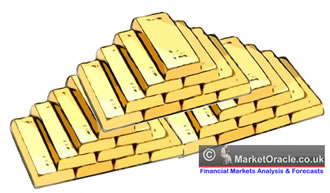The MOST Important Investment You Can Make!
Commodities / Gold & Silver 2009 May 04, 2009 - 03:41 PM GMTBy: Uncommon_Wisdom
 Larry Edelson writes: Now, to be sure all my readers know what I consider the most important investment you can make, or will ever make, in addition to reading my column published last Monday on my top three gold mining shares, today I want to make absolutely certain you also own physical gold.
Larry Edelson writes: Now, to be sure all my readers know what I consider the most important investment you can make, or will ever make, in addition to reading my column published last Monday on my top three gold mining shares, today I want to make absolutely certain you also own physical gold.
Why? Because no portfolio is safe from today’s whirlwind of events and economic forces without gold.
In fact, I’m just back from three months in Asia, and no matter how often I visit … how much time I spend there … or wherever I go in Asia, I’m always amazed by a single phenomenal sight: People buying gold — and loads of it!
I don’t mean just gold stocks and mutual funds, gold certificates or gold exchange-traded funds (ETFs). They buy pure gold. Gold jewelry … gold coins … gold bullion … and gold bars. And you should too.
Indeed, if you’ve ever been to Asia then you know it’s virtually impossible to walk down a street in any major Asian city without seeing at least one gold shop. Often, there are two or three to a block. And they’re packed with buyers. More so these days than ever before.
This is particularly true of Bangkok, where I spend a lot of time, and where near constant political dissent frequently drives Thais to buy gold hand over fist.
But it’s not just Thailand. Gold demand is on fire in China, India, and the Middle East. Everywhere, the rush for gold is soaring and it’s quickly becoming a veritable stampede.
Some recent stats from the World Gold Council …
 |
| Gold demand is soaring in India, the world’s largest gold market. |
![]() Total demand in India, the world’s largest gold market, was up 84 percent in the fourth-quarter of 2008 over a year earlier …
Total demand in India, the world’s largest gold market, was up 84 percent in the fourth-quarter of 2008 over a year earlier …
![]() Gold demand in Greater China was up 21 percent …
Gold demand in Greater China was up 21 percent …
![]() Demand in Thailand soared over 100 percent, while …
Demand in Thailand soared over 100 percent, while …
![]() Middle Eastern gold bar and coin demand soared 139 percent!
Middle Eastern gold bar and coin demand soared 139 percent!
Record demand has also spilled into the first quarter of this year, sending total global demand for gold in the form of ETFs, coins, bars and futures past the $100 billion mark, for the first time ever.
Moreover, gold demand via ETFs shot up an amazing 469 metric tonnes — a full 223 percent over the previous record set in the third quarter of 2008. Coin and bullion demand is expected to be just as strong as the 396 percent surge in Q4 2008.
It should be no surprise then that the price of gold continues to trade above its 1980 high of $850 … its bull market more powerful than almost anyone is ready to admit … preparing for an eventual move to my target of at least $2,270 gold — as soon as a year from now.
This is precisely why I believe everyone should own some gold and why it’s a core component of the recommended holdings in my Real Wealth Report.
I suggest a combination of a gold ETF, gold stock mutual funds, shares in top-notch gold mining companies like the ones I mentioned in last week’s column and in Real Wealth, and physical gold!
So how do you go about investing in physical gold? That’s a great question so let’s get right to it …
How to Buy and Safeguard Your Gold
In the last 36 years, a series of new gold bullion coins have hit the market: The South African Krugerrand in 1970 … the Canadian Gold Maple Leaf in 1979 … the U.S. Gold American Eagle in 1986 … and, most recently, the Singapore Lion in 1990.
And that’s just a sample list.
Are gold bullion coins a good investment? Sure. But if you buy coins, you’re going to pay for the fancy design and the rarity of the coin itself. And that can add up to a hefty premium over the actual value of the gold content, as much as 7 percent, or more.
Put another way, the price of gold would have to rise 7 percent just for you to break even on the investment.
Buy Small Gold Bars
 |
| If you want to own physical gold, I recommend small gold bars. |
Instead, if you’re interested in physical gold, I recommend you invest in small gold bars. You can buy them in a wide range of weights — from one to 1,000 grams.
They contain a minimum of 99.5 percent fine gold and don’t carry the premium that gold coins do. You can buy small gold bars or ingots for as little as 1 percent over the price of gold.
Right now, there are 94 accredited manufacturers of small gold bars that produce a staggering 400 different gold bars among them.
Which to choose? Any one of the 94 accredited manufacturers is fine. But to help you narrow down your choices, I like Engelhard, Johnson Matthey, and PAMP.
Now, when buying gold, it’s important to keep these five rules in mind …
Rule #1. Don’t store your gold with the dealer you bought it from.
Sounds simple enough, doesn’t it? But the fact remains that countless investors have been burned when their gold dealer went bankrupt: Ruffco … National Bullion … North American Coin & Currency … and Bullion Reserve are just a few gold dealers that went belly up.
And mark my words, as the price of gold continues to skyrocket, you’ll likely see more bankruptcies, not less, down the road. In gold bull markets, the buying frenzy seems to attract the least prudent and least ethical players to the bullion industry.
Rule #2. Take possession of your gold using one of these alternatives.
Look at it this way: When you purchase physical gold, the farther you remove your bullion — legally and physically — from the dealer, the safer it is from the claims of that dealer’s creditors.
![]() Alternative A: Cash & Carry. In terms of getting what you paid for, buying your gold and taking it with you is the ultimate solution.
Alternative A: Cash & Carry. In terms of getting what you paid for, buying your gold and taking it with you is the ultimate solution.
You go to your dealer, inspect what you’re buying, make your purchase, and walk out the door with your gold in hand. Simple. (But remember: Driving around town with a bag of gold has its own security risks.)
![]() Alternative B: Consignment Method. The dealer sends the bullion to you for your inspection and then you send the money. It’s a great choice and gives you plenty of leverage. If you can find a dealer to go for it, you’re golden. Just have them send the metal to you and then you respond with a check the minute you’re satisfied you’ve got what you were promised.
Alternative B: Consignment Method. The dealer sends the bullion to you for your inspection and then you send the money. It’s a great choice and gives you plenty of leverage. If you can find a dealer to go for it, you’re golden. Just have them send the metal to you and then you respond with a check the minute you’re satisfied you’ve got what you were promised.
![]() Alternative C: Sight Drafts. You make an arrangement with your bank to act as an intermediary between you and the gold dealer. The dealer sends the gold to the bank. The bank then holds it for your inspection. When you give the OK, the bank issues a cashier’s check and you take possession of the metal.
Alternative C: Sight Drafts. You make an arrangement with your bank to act as an intermediary between you and the gold dealer. The dealer sends the gold to the bank. The bank then holds it for your inspection. When you give the OK, the bank issues a cashier’s check and you take possession of the metal.
Rule #3. Use a major, independent depository to safeguard your gold.
I prefer Brinks (718-949-2186) … HSBC Bank USA (212-525-6439) … and Manfra, Tordella & Brookes, Inc. (212-981-4516) — all located in New York and all approved New York Mercantile Exchange gold depositories.
Rule #4. Use non-fungible storage.
When you put your gold in non-fungible storage, it means it’s stored in your name and it’s not pooled with bullion from other customers. This keeps your gold nice and tidy — and it’s really the best way to go.
However, just because your dealer says your bullion is non-fungible and completely segregated doesn’t necessarily make it so.
And even if your metal is segregated, that doesn’t mean the segregation agreement will automatically stand up in court. The best way to make sure is to have your attorney review the firm’s paperwork.
Either way, always specify that you want non-fungible storage. It may cost a bit more, but it’s worth every penny.
Rule #5. Consider offshore purchases and storage.
If you’ve spent any time reading my thoughts here or in Real Wealth Report, you know I don’t trust gold dealers, politicians and government bureaucrats. And there are also bankers I don’t trust.
Nor do a lot of other people. That’s why so much gold is stored in Switzerland and Australia. I especially like the Gold Certificate Program at the Perth Mint of Australia. Features …
1. The world’s only government-guaranteed certificate program 2. Insured by Lloyd’s of London at the Perth Mint’s expense 3. Low minimum purchase requirements of $10,000 to get started 4. Segregated storage available 5. Storage in a government vault, not a foreign bank 6. Gold, silver, platinum and palladium available — in coin or bullion 7. Permitted in Individual Retirement Accounts (IRAs)
What happens when you want your gold? Just present your certificate by mail or in person to the Perth Mint, pay any related charges, and then tell them where you want your gold shipped. It’s simple and easy.
For my latest core gold and natural resource recommendations, including how to invest the recommended gold allocation … and specific recommendations for short-term profits — join me in Real Wealth Report.
It will be one of the best investment decisions you’ll make this year. I guarantee it. Click here to join now.
Best wishes for your health and wealth,
Larry
This investment news is brought to you by Uncommon Wisdom. Uncommon Wisdom is a free daily investment newsletter from Weiss Research analysts offering the latest investing news and financial insights for the stock market, precious metals, natural resources, Asian and South American markets. From time to time, the authors of Uncommon Wisdom also cover other topics they feel can contribute to making you healthy, wealthy and wise. To view archives or subscribe, visit http://www.uncommonwisdomdaily.com.
Uncommon Wisdom Archive |
© 2005-2022 http://www.MarketOracle.co.uk - The Market Oracle is a FREE Daily Financial Markets Analysis & Forecasting online publication.
Comments
|
adam
04 May 09, 18:50 |
too much sales like!!!
it sounds like a jewelery sales man , the article does not have a MUST HAVE objectivity |



